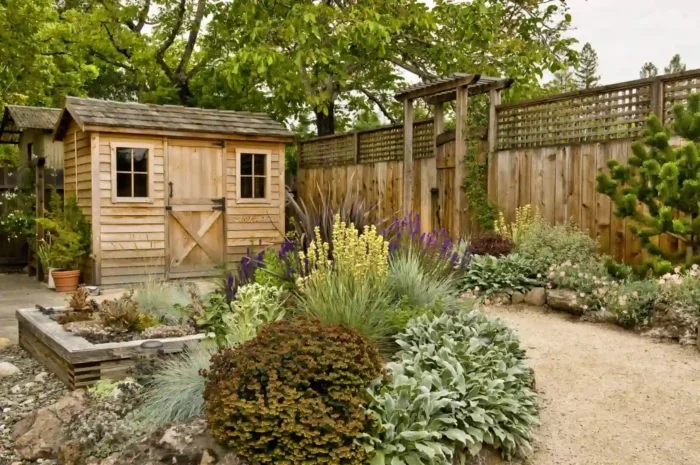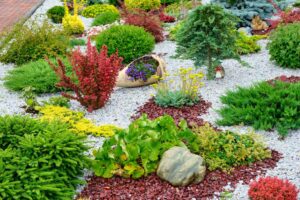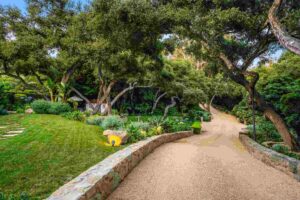If you’re planning a yard makeover or looking for low-cost ground cover, you’ve likely heard the term DG thrown around. This material has become a go-to choice for homeowners and pros alike. But what exactly is it, and why does everyone seem to love it?
DG stands for decomposed granite, a natural stone material that works great for paths, patios, and garden beds. It’s cheap, looks good, and needs little care once installed. Let’s break down everything you need to know about this popular landscaping option.
Understanding What Is DG in Landscaping
Decomposed granite is exactly what it sounds like granite rock that has broken down over time into smaller pieces. Nature does most of the work through weathering and erosion. The result is a mix of small particles that range from fine sand to tiny gravel bits, usually about 1/4 inch or smaller.
This material comes in colors that match the original granite stone. You’ll find shades of tan, brown, gray, gold, and even reddish tones. The color depends on where it was quarried and what minerals were in the original rock.
Unlike regular gravel or crushed stone, DG packs down tight when you wet it and roll it. This creates a firm surface that still lets water drain through. That’s why it works so well for walkways and outdoor spaces where you want something stable but not totally solid like concrete.
The particles in decomposed granite contain some clay and fine sediment. When these get wet and compressed, they act like natural glue. This binding quality sets DG apart from plain sand or loose rock.
Decomposed Granite Types for Landscaping

Not all decomposed granite is the same. You’ll find three main types, each with different uses and benefits.
Natural or Loose DG
This is pure decomposed granite with nothing added. It’s the most affordable option and drains water really well. The particles stay loose and shift around when you walk on them, kind of like sand at the beach.
Natural DG works great as mulch in garden beds or around trees. It helps stop weeds and keeps soil moist. But it’s not the best choice for paths since it can scatter and track into your home. You’ll need to add more every year or two as it settles and breaks down.
Stabilized Decomposed Granite
This type has a stabilizer added to it usually a natural resin or polymer. The stabilizer helps the particles stick together better than natural DG alone. When installed right, it creates a firmer surface that stays put.
Stabilized DG is perfect for paths, driveways, and patios. It holds up to foot traffic and won’t wash away in heavy rain as easily. The surface still drains well but stays compact. Most pros recommend this type for any area where people will walk regularly.
Resin-Coated DG
This is the premium option. Each granite particle gets coated with a special resin before installation. When laid down and watered, the resin activates and the whole surface bonds together into a solid but permeable layer.
Resin-coated decomposed granite creates the hardest, most durable surface. It’s great for high-traffic areas, sports courts, or anywhere you need a really stable base. The cost is higher, but it lasts longer and needs almost no maintenance. Water still soaks through, so you won’t deal with puddles.
Using Decomposed Granite in Landscaping
Decomposed granite landscaping offers tons of possibilities. Here are the most common ways people use this material.
Pathways and Walkways
DG paths give your yard a natural, casual look. They’re softer underfoot than concrete and much cheaper to install. You can create curved or straight paths that wind through gardens or connect different areas of your property.
For best results, use stabilized or resin-coated DG for paths. These types handle foot traffic better and won’t scatter everywhere. A typical path needs a 3-4 inch base layer compacted down to 2-3 inches.
Patios and Sitting Areas
A crushed granite landscaping patio costs way less than pavers or concrete. The surface stays cool in summer, which is nice for bare feet. You can easily add outdoor furniture without worrying about uneven spots.
The key is proper prep work. You need landscape fabric underneath to block weeds, then edge restraints to keep the DG contained. Compact each layer well, and you’ll have a patio that lasts for years.
Garden Mulch and Ground Cover
Natural DG makes excellent mulch around plants and in planting beds. It doesn’t float away like bark mulch during heavy rain. The tan and brown colors look clean and let your plants stand out.
A 2-3 inch layer of decomposed granite garden mulch helps control weeds and holds moisture in the soil. It also keeps dirt from splashing onto plant leaves when it rains. Just keep it a few inches away from plant stems to prevent rot.
Driveways and Parking Areas
If you have a long driveway, DG can save you thousands compared to asphalt. It works especially well for secondary driveways or parking spots that don’t get daily use.
Choose stabilized or resin-coated types for driveways. Plain natural DG will rut and wash out under car tires. You’ll also need a thicker base usually 4-6 inches compacted. Proper drainage is critical to prevent washouts during storms.
Play Areas and Dog Runs
Decomposed granite is softer than concrete but firmer than bark, making it a solid middle-ground option for play spaces. It drains well, so puddles don’t form after rain. Dogs can’t dig it up as easily as mulch.
The fine texture is gentler on paws and knees if someone falls. Just check that kids don’t track too much inside the small particles can stick to shoes and get carried indoors.
You may read Does Landscaping Increase Home Value?
Installation Tips for DG Landscaping Success
Getting great results with DG landscaping comes down to good prep and proper installation methods.
Start by clearing the area and removing any grass, roots, or debris. Dig down 4-6 inches depending on your project. You want enough depth for your base layers plus the final DG surface.
Install edge restraints around the perimeter. Use metal, plastic, or wood edging to contain the material. Without edges, DG will slowly spread into surrounding areas.
Lay down landscape fabric over the soil. This blocks weeds from growing up through the DG while still allowing drainage. Overlap seams by at least 6 inches.
Add a base layer of crushed rock if needed. For driveways or high-traffic areas, a 2-3 inch base of 3/4-inch rock helps with stability and drainage. Compact it well with a plate compactor.
Apply the DG in layers. Pour it out and spread it evenly with a rake. Work in 1-2 inch layers, spraying each with water and compacting before adding the next layer. This process takes time but creates a much better surface.
Keep adding water as you compact. The material should feel damp but not soaking wet. Too much water makes a muddy mess; too little won’t activate the binding properties.
For stabilized or resin-coated types, follow the product instructions carefully. Some need to be mixed first, others get applied dry and then watered. The activation process is critical for proper bonding.
Maintenance and Care for Decomposed Granite
One reason people love DG is the low maintenance. But it’s not completely hands-off.
Rake the surface occasionally to keep it even. High-traffic spots can develop shallow depressions over time. A quick rake spreads the material back out.
Add fresh DG every 1-3 years depending on traffic and weather. Natural types need more frequent topping than stabilized versions. A thin new layer keeps everything looking fresh.
Pull weeds as soon as you spot them. While DG resists weeds better than many materials, some tough plants still push through. Getting them early prevents root systems from establishing.
Clean up leaves and debris regularly. Decomposing organic matter can create a layer where weed seeds sprout. A leaf blower works great for this job.
For stabilized or resin-coated surfaces, you might be able to rinse them with a hose. Check your product specs some can handle pressure washing while others might break down.
Repair thin spots right away. If you see areas wearing down to the fabric or base layer, add more DG and compact it. Catching problems early prevents bigger repairs later.
Cost Comparison: DG vs Other Materials
Budget matters in any project. Here’s how decomposed granite stacks up against common alternatives.
DG costs roughly $40-$60 per cubic yard for natural types. Stabilized runs $50-$80 per yard, and resin-coated can hit $100+ per yard. These prices vary by location and availability.
Compare that to concrete at $8-$12 per square foot installed, or pavers at $10-$25 per square foot. Even accounting for base materials and labor, a DG patio or path costs 50-70% less than hardscape alternatives.
Gravel is cheaper per yard but doesn’t compact like DG. You’ll spend more time maintaining loose gravel, which shifts and spreads. DG’s binding quality makes it worth the small price difference.
Bark mulch seems cheap initially, but you replace it every year or two. DG lasts much longer between touch-ups. Over five years, DG actually costs less than quality bark mulch in most cases.
Professional installation for DG projects typically runs $3-$8 per square foot including materials and labor. DIY can cut costs by 50-60% if you have the time and tools.
Environmental Benefits of Using DG
Choosing what is DG in landscaping also makes sense from an environmental angle.
DG is permeable, meaning water soaks through instead of running off. This helps recharge groundwater and reduces strain on storm drains. In areas with water restrictions, permeable surfaces often don’t count against your hardscape limits.
The material is natural and doesn’t require manufacturing like concrete or asphalt. Mining and crushing granite uses energy, but less than producing cement or petroleum-based materials.
DG reflects heat better than dark asphalt or pavers. This helps reduce the urban heat island effect, especially in hot climates. Your yard and surrounding areas stay a bit cooler.
No chemicals or treatments are needed. Unlike treated wood or some synthetic materials, DG won’t leach anything harmful into your soil or water supply.
When DG eventually breaks down completely, it returns to earth as natural sediment. There’s no waste disposal problem like with concrete demolition.
Common Problems and Solutions
Even with proper installation, you might run into these issues.
Erosion: Heavy rain can wash out DG, especially on slopes. Fix this by using stabilized types, creating better drainage channels, or adding edge restraints at intervals down the slope.
Tracking indoors: Fine particles stick to shoes and paws. Place a good doormat outside entries, or create a transition area with larger stones where people naturally brush off their feet.
Settling and compaction: Over time, DG packs down and the surface can drop. Simply add a fresh layer and re-compact. This is normal maintenance, not a failure.
Weed growth: If weeds break through, check that your landscape fabric is intact. Repair any tears or holes. Use a pre-emergent herbicide around the edges if weeds become a big problem.
Dustiness: In dry conditions, fine DG particles can create dust. Spraying the surface lightly with water helps. For frequent use areas, stabilized types eliminate this issue almost completely.
Start Using Expert Services
Taking on a dg landscaping project yourself is doable, but there are advantages to working with pros who know the material inside and out. Lakota Design Group specializes in landscape installation in San Jose and understands how local conditions affect DG performance. Expert installers know proper base preparation, grading for drainage, and compaction techniques that make the difference between a surface that lasts one year versus ten years. They also have the right equipment plate compactors, graders, and proper edging tools that most homeowners don’t own.
Conclusion
Decomposed granite offers a practical, attractive option for yards, paths, and outdoor spaces. It costs less than concrete or pavers, drains better than solid surfaces, and needs minimal upkeep once installed. The three types natural, stabilized, and resin-coated each serve different purposes, so pick the right one for your specific project. With proper installation and basic care, a decomposed granite surface can last for many years. Ready to transform your outdoor space? Contact Lakota Design Group today to discuss your project and get started on creating the landscape you’ve been dreaming about.
FAQs
How long does decomposed granite last?
Natural DG lasts 3-5 years before needing replacement. Stabilized types last 5-8 years with light use. Resin-coated can last 10+ years in residential settings. Lifespan depends on traffic levels and weather exposure.
Can you drive on decomposed granite?
Yes, but use stabilized or resin-coated types for driveways. You need a proper 4-6 inch compacted base. Natural DG will rut and wash out under vehicles.
Is DG safe for dogs?
DG is generally safe for dogs. It’s softer than concrete but won’t splinter like wood chips. Some dogs might eat small amounts out of curiosity, but it passes through harmlessly. Keep water available since the surface can get warm.
Does decomposed granite get muddy?
Properly installed DG drains well and doesn’t turn muddy. If it becomes muddy, either the base prep was insufficient or water is pooling instead of draining away. Check your grading and drainage.
How much DG do I need for my project?
Measure your area in square feet and multiply by the depth in inches, then divide by 324 to get cubic yards needed. A 100 square foot patio at 3 inches deep needs about 1 cubic yard of DG.





